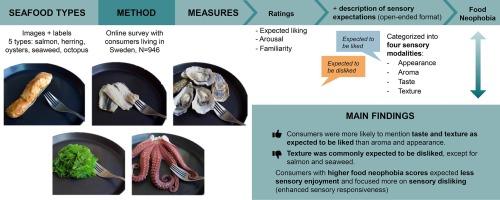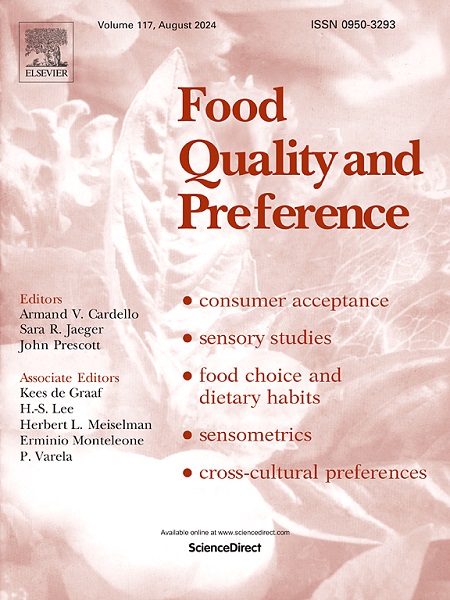通过分析消费者对海鲜的开放式描述,揭示食物新恐惧症与感官期望之间的负面联系
IF 4.9
1区 农林科学
Q1 FOOD SCIENCE & TECHNOLOGY
引用次数: 0
摘要
食物恐新症(FN)--即不愿意尝试新奇食物--在进化过程中可能起到了防止食用有害食物的保护作用。然而,在现代社会中,FN 是限制饮食多样性的一个主要障碍,对人们接受新食物和熟悉食物都有负面影响。本研究通过在线调查(居住在瑞典的成年人,n = 946)研究了 FN 对五种海鲜(鲑鱼、鲱鱼、牡蛎、章鱼和海藻;以标签图像呈现)感官预期的影响。参与者对预期喜欢程度、情绪唤醒程度和感知熟悉程度进行评分(量化量表),并用自己的话描述他们预期喜欢和不喜欢的感官方面(开放式回答)。对开放式回答进行了定性评估,并将其分为四种感官模式(外观、香气、味道和质地)。对鲑鱼的预期喜欢程度最高(其次是鲱鱼、海藻,最后是章鱼和牡蛎),除鲑鱼外,FN 与所有物种的预期喜欢程度呈负相关,这可能是由于在瑞典人们熟悉并经常食用鲑鱼所致。Logistic 回归用于评估自发提及喜欢或不喜欢每种感官方式的可能性是否因物种和 FN 分数而异。结果显示,对于除生蚝以外的所有样品,参与者更倾向于提及喜欢味道和质地,而不是香气和外观。鲱鱼、牡蛎和章鱼通常不喜欢口感,但三文鱼和海藻则不然。FN 分数越高,提及所有感官模式为不喜欢的可能性越大,提及所有感官模式为喜欢的可能性越小。因此,较高的 FN 水平既与对感官不喜欢的关注增加有关,也与对所有感官方式的预期感官享受降低有关。这些结果表明,FN 至少部分是由感官反应性的增强所驱动的,并强调了在品尝之前了解预期的重要性。本文章由计算机程序翻译,如有差异,请以英文原文为准。

The negative association between food neophobia and sensory expectations revealed through analysis of consumers’ open-ended descriptions of seafood
Food neophobia (FN) – the reluctance to try novel foods – may have served a protective, evolutionary function against consuming harmful foods. In modern societies, however, FN is a major barrier that limits dietary variety and negatively impacts acceptance of both new and familiar foods. Using an online survey (adults living in Sweden, n = 946) this study investigated the influence of FN on sensory expectations of five types of seafood (salmon, herring, oysters, octopus, and seaweed; presented as labelled images). Participants rated expected liking, emotional arousal, and perceived familiarity (quantitative scales) and described the sensory aspects they expected to like and dislike using their own words (open-ended responses). The open-ended responses were evaluated qualitatively and categorized into four sensory modalities (appearance, aroma, taste, and texture). Expected liking was highest for salmon (followed by herring, seaweed, and lastly octopus and oysters), and FN was negatively associated with expected liking for all species except salmon, possibly due to being familiar and regularly consumed in Sweden. Logistic regression was used to evaluate whether the likelihood of spontaneously mentioning each sensory modality as liked or disliked varied by species and FN score. This revealed that participants were more likely to mention liking aspects of taste and texture than aroma and appearance for all samples except oysters. Texture was commonly disliked for herring, oysters, and octopus, but not for salmon and seaweed. Higher FN scores increased the likelihood of mentioning all sensory modalities as disliked and decreased the likelihood of mentioning all sensory modalities as liked. Thus, higher levels of FN were associated with both an increased focus on sensory disliking, and lower expected sensory enjoyment across all modalities. These results suggest that FN may be at least partly driven by heightened sensory responsiveness and highlight the importance of understanding expectations prior to tasting.
求助全文
通过发布文献求助,成功后即可免费获取论文全文。
去求助
来源期刊

Food Quality and Preference
工程技术-食品科技
CiteScore
10.40
自引率
15.10%
发文量
263
审稿时长
38 days
期刊介绍:
Food Quality and Preference is a journal devoted to sensory, consumer and behavioural research in food and non-food products. It publishes original research, critical reviews, and short communications in sensory and consumer science, and sensometrics. In addition, the journal publishes special invited issues on important timely topics and from relevant conferences. These are aimed at bridging the gap between research and application, bringing together authors and readers in consumer and market research, sensory science, sensometrics and sensory evaluation, nutrition and food choice, as well as food research, product development and sensory quality assurance. Submissions to Food Quality and Preference are limited to papers that include some form of human measurement; papers that are limited to physical/chemical measures or the routine application of sensory, consumer or econometric analysis will not be considered unless they specifically make a novel scientific contribution in line with the journal''s coverage as outlined below.
 求助内容:
求助内容: 应助结果提醒方式:
应助结果提醒方式:


